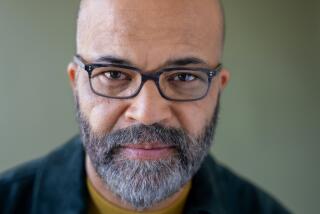Samuel Fuller’s daughter shoots for a big anniversary celebration

Maverick independent director Samuel Fuller, who helmed such provocative films as 1951’s “The Steel Helmet,” 1953’s “Pickup on South Street” and 1980’s “The Big Red One,” was 63 when he had his only child, Samantha.
“He always reassured me that he would be around for his 100th birthday and we would have a big party,” Samantha Fuller recalled on a recent afternoon in the living room of the filmmaker’s house in the Hollywood Hills that she still shares with her mother, Christa, and her own teenage daughter, Samira. As far as the eye can see are boxes and tubs filled with her father’s pictures, letters and other memorabilia.
“He died at the age of 85. I always knew in my head that his centennial would be something personally I would want to celebrate.”
PHOTOS: Samuel Fuller’s ‘shack’
Fuller, 37, who designs glass jewelry and platters, realized on her father’s 99th anniversary on Aug. 12, 2011, that she’d better get going on her tribute.
So she decided to make a personal documentary on her dad, “A Fuller Life.” She’s completed the first 50 minutes of it; the project is currently on Kickstarter to help raise the $25,000 needed to complete the feature-length film she hopes will be ready for release next year.
Fuller found her inspiration last year by going to “the shack,” the garage where her father wrote his screenplays. It has remained basically untouched for 15 years.
“I went back into the shack, cleaning up some spider webs and maintaining it to a minimum. It dawned on me it would be the perfect setting to commemorate him.”
She selected 12 passages from the autobiography her father wrote with his wife and Jerry Rudes, “A Third Face,” highlighting historical events in his life, and filmed a variety of actors and directors reading these excerpts in the shack: James Franco, Tim Roth, Bill Duke, Wim Wenders, Buck Henry, James Toback, Monte Hellman and the four leads from “The Big Red One” — Robert Carradine, Mark Hamill, Perry Lang and Kelly Ward — a film that was based on Fuller’s experiences with the 16th Infantry Regiment, 1st Infantry Division.
She hopes with the Kickstarter funds to add clips from her father’s films and 16 mm footage of him at work that she found in the shack.
“I didn’t realize what I was getting into, but I am happy to be in it and I am going to take it to the end,” she said.
It was her father’s experiences that fueled his tough, uncompromising and often polarizing war films, dramas, melodramas and even westerns.
“We talk about the Great Depression and how he was a freelance reporter throughout the ‘30s and crossed the United States from coast to coast with his typewriter and his backpack,” said Fuller.
Her father, she said, “witnessed executions and he infiltrated KKK meetings. He saw the general strike in San Francisco in 1934. We also talk about his experiences in World War II — in the infantry for four years, North Africa, Italy, D-Day. He was a soldier at heart.”
Fuller offers a tour of the shack, which has a comforting, musty smell. Her father may be gone, but one can sense him everywhere in the copies of countless Liberty magazines he wrote for, rifles from the war, his favorite Royal typewriter, his off-white jacket on a hanger, embossed scripts of the films that he made and overflowing bookshelves with unproduced scripts and story concepts with such titles as “Snug Harbor” and “The Three Most Wanted Men.”
“I would say there are about 20 scripts that are timeless and just waiting [to be filmed],” said Fuller, who puts on a German helmet from World War II, complete with bullet hole.
“He took it off a corpse, buried it, marked the spot where he buried it and went back years later and found it,” she said.
There’s also a scattershot of ammunition in random boxes.
“Do you know the story of guns on the set?” Fuller asked. “He had guns and rifles on the set because he didn’t like to call ‘action.’ So he would shoot the gun to get real emotion.”
PHOTOS AND MORE:
PHOTOS: Hollywood back lot moments
Latest movie reviews
PHOTOS: NC-17 movies: Why they got the rating
More to Read
Only good movies
Get the Indie Focus newsletter, Mark Olsen's weekly guide to the world of cinema.
You may occasionally receive promotional content from the Los Angeles Times.







